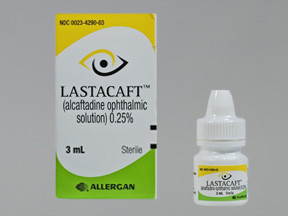ALCAFTADINE - OPHTHALMIC
PHONETIC PRONUNCIATION: (al-KAF-ta-deen)
COMMON BRAND NAME(S): Lastacaft
GENERIC NAME(S): alcaftadine
Uses
USES: This medication is used to prevent itching of the eyes due to allergies. Alcaftadine is an antihistamine. It works by blocking a certain natural substance (histamine) that causes allergic symptoms. Do not use this medication to treat red or irritated eyes due to wearing contact lenses. Contact your doctor for further instructions if this occurs.
How to use ALCAFTADINE - OPHTHALMIC
HOW TO USE: Apply this medication in both eyes as directed by your doctor, usually once a day. Wash your hands before each use. To avoid contamination, do not touch the dropper tip or let it touch your eye or any other surface. The preservative in this product may be absorbed by contact lenses. If you wear contact lenses, remove them before using this medication and keep them out of your eyes for at least 10 minutes after each dose. Do not wear contact lenses if your eyes are red. Tilt your head back, look upward, and pull down the lower eyelid to make a pouch. Hold the dropper directly over your eye and place one drop into the pouch as directed by your doctor. Look downward, gently close your eyes, and place one finger at the corner of your eye (near the nose). Apply gentle pressure for 1 to 2 minutes before opening your eyes. This will prevent the medication from draining out. Try not to blink or rub your eye. Repeat these steps for your other eye. Do not rinse the dropper. Replace the dropper cap after each use. If you are using another kind of eye medication (for example, other drops or ointments), wait at least 5 minutes before applying other medications. Use eye drops before eye ointments to allow the drops to enter the eye. Use this medication regularly to get the most benefit from it. To help you remember, use it at the same time each day. Do not use this product if it becomes contaminated (for example, drops turn a dark color). Using contaminated eye medication can cause infection, serious damage to the eye, and loss of vision. Contact your doctor or pharmacist for more information. Tell your doctor if your condition does not improve in a few days or if it worsens.
Side Effects
Precautions
Interactions
Overdose
Images
Reviews
Faq for ALCAFTADINE - OPHTHALMIC
Alcaftadine ophthalmic is used to temporarily relieve symptoms of allergic conjunctivitis, such as itching, redness, and watering of the eyes.
Alcaftadine ophthalmic works by blocking histamine, a substance in the body that causes allergic reactions. This helps to reduce inflammation and relieve allergy symptoms in the eyes.
Alcaftadine ophthalmic is typically used as eye drops. Wash your hands before applying the drops and tilt your head back slightly. Pull down your lower eyelid to create a small pocket and squeeze one drop into the pocket. Blink a few times to spread the medication. Repeat the process if directed to use more than one drop.
Common side effects may include eye irritation, blurry vision, a bitter taste in the mouth, and headache. Contact your doctor if these side effects persist or worsen.
You should remove your contact lenses before using Alcaftadine ophthalmic. Wait at least 10 minutes before reinserting your lenses after applying the eye drops.
Alcaftadine ophthalmic is generally safe for use in children aged 2 years and older, but it is always recommended to consult with a pediatrician before using any medication.
The effects of Alcaftadine ophthalmic can usually be felt within a few minutes after application. However, it may take a few days of regular use to experience maximum relief from allergy symptoms.
It is generally safe to use Alcaftadine ophthalmic with other eye medications, but it is best to consult with an eye care professional or pharmacist to ensure there are no potential interactions.
It is generally recommended to avoid using Alcaftadine ophthalmic during pregnancy or breastfeeding unless prescribed by a healthcare professional. It is important to discuss the potential risks and benefits with your doctor.
Disclaimer
IMPORTANT: HOW TO USE THIS INFORMATION: This is a summary and does NOT have all possible information about this product. This information does not assure that this product is safe, effective, or appropriate for you. This information is not individual medical advice and does not substitute for the advice of your health care professional. Always ask your health care professional for complete information about this product and your specific health needs.

No Reviews Yet